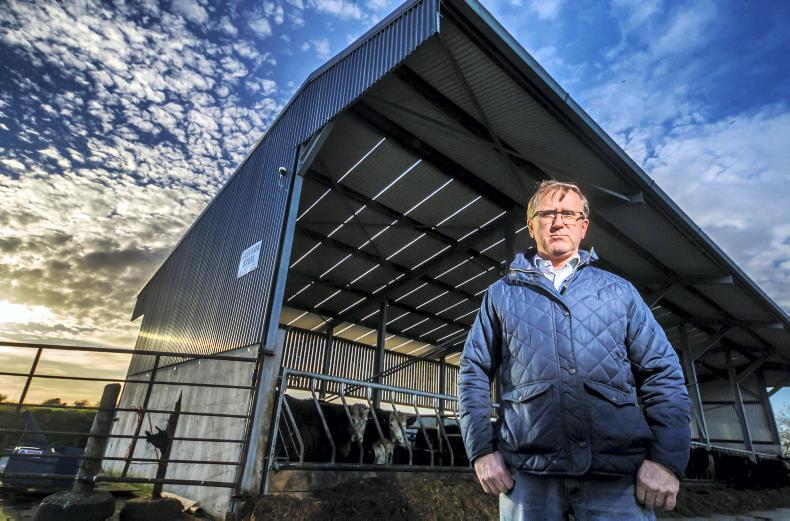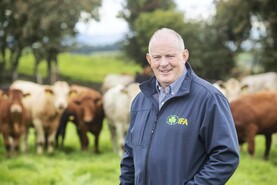Billy Glasheen is no stranger to crunching figures. Having worked as a financial controller for a number of multinational manufacturing firms for 30 years, it gave him the appetite for budgets and spreadsheets.
He now uses this financial experience to analyse his finishing business on a weekly basis, meticulously inputting all costs and outputs to allow him look at what’s left at the end of the year. Billy finishes over 200 cattle annually, predominantly Angus and Hereford cross, and kills them locally in Wexford.
“I think in general people stick their heads in the sand when it comes to looking at the level of profit that is being made out of the finishing business. At the moment, finishers are losing money hand over fist and nobody seems to give a damn about them.”
Billy has become increasingly frustrated with the level of profit from his finishing business, so much so that last year he took the difficult decision to lease his farm in Tipperary to a neighbouring dairy farmer.
“When I looked at the figures as to what I could get from leasing the farm versus finishing, it was a no-brainer to lease the farm and I think if more beef farmers were honest with themselves, we would see a lot more farms up for leasing.”
Billy continues to finish cattle on his Waterford farm but he questions how much longer his farm can continue to work for zero return at the rate it’s currently happening.
Budgets
Whether you are running a manufacturing business making widgets or running a retail unit selling umbrellas to a shopper or a beef farmer producing beef, the first thing you should know is your cost of production so you can set a selling price that delivers you a profit on your enterprise. It’s simple economics, but many a business has failed because of getting costs of production wrong.
In the beef production business, beef finishers don’t have the benefit of being able to set the selling price. However, you still need to know your costs of production per kg. “For whatever reason, in relation to beef costs of production Teagasc seem to focus purely on breakeven cost, which is not the full cost of production because it excludes own and family labour,” Billy added.
The Glasheen budget
Billy has assumed a 50ha farm in all systems. Fixed costs and labour costs are calculated by dividing cost by the number of stock sold in the period. So, to calculate the labour cost, the farmer or research person calculating a cost of production inputs the estimated hours along with the hourly labour rate to calculate labour total cost. This is then divided out by the number of cattle sold in the period. This means that the greater the output the more labour and fixed costs get diluted and therefore result in greater efficiencies within the farm system. Billy highlights a number of issues with the Teagasc beef budgets.
Single farm payment v land charge
People may ask where the Basic Payment comes into the figures. In essence, this was introduced by the EU to compensate farmers for higher production costs and lower farmgate prices. In Billy’s view, this simply covers the land charge for his finishing business. This payment is linked to the land, not to the output from the farm. If you took the national average BPS payment at €265/ha, this can be calculated at just covering a land charge of just over €100/acre. This could be perceived as low for some parts of the country, but it means that the Basic Payment is excluded.
Fixed costs
Fixed costs, which are the other costs not directly related to livestock feed, animal health and marketing costs, include other expenses such as depreciation, machinery/buildings repairs, land maintenance charges, motor expenses, insurance, fuel and other expenses. These costs should be allocated over the number of livestock sold in the year. So, for example, if fixed costs are €650/ha, which would be just above average on many well-run beef farms, and sales of four livestock per hectare occurred in the year, your fixed costs would be divided over the four sales – €163 fixed cost charge per head. If there are many different types of stock sales, fixed costs could be calculated by dividing fixed costs by the total kg of beef produced from your profit monitor. So, for example, if you have total fixed costs of €25,000 and your gross output was 50,000kg, for every kg beef produced it costs €0.50/kg in fixed costs.
Labour costs
Own and family labour must be calculated by working out how many hours are consumed by the farm directly and indirectly (farm administration and research) weekly and over the year. Total hours are then multiplied by the labour rate the farmer decided he is prepared to work for. So if total hours are calculated at 2,600 for the year and he decided to charge a labour rate of €13.50 per hour, that’s €32,500 total labour charge, or €0.65 per kg beef produced assuming the 50,000kg gross output above.
For this analysis, we have assumed a 50ha beef farm and the farmer estimates he works 50 hours on his beef farm business per week on average over the year, or 2,600 hours. We are assuming a labour rate of €12.50 per hour. That is a total labour cost for the farm over the year of €32,500. Every farmer should estimate or record the time he or his family puts into the farm and decide what labour hourly rate they want for their efforts. Like fixed costs, labour is allocated out over the output of the farm (number of animals sold) during the year.
The grid: Pay the farmer on meat yield and scrap the current quality payment grid. Factory returns should show liveweight, carcase deadweight and meat yield weight. Three weights but paid on the final column, the yield. This price could be linked to wholesale prices if payments were made on beef yield.
The bottom line: Beef farmers have to ask the question is it sustainable to produce and sell beef at below the costs of production.
Cost of production: I think we have a responsibility to tell producers what the actual cost of beef production is and then let beef finishers make up their own mind about whether they should stay in production or not.
Value: I would love to see a forensic analysis of the value added of a unit of finished livestock, farm to fork. Who is capturing the value added and where the biggest profit is made.
Climate change: Beef farmers need to become climate change leaders by best practice climate change farming, energy crops, more forestry, biogas energy co-ops, solar panels on sheds, wind turbines. This requires EU grant support.
Inputs: Farm input prices are continuously rising year on year but farm output prices are flat and this year dropping. We need a 10-year rolling index of farm input prices and farm output revenues to flag this.
South America: We have seen very high imports of beef from South America in 2018, 288,587t to the end of October. We have to ask ourselves the question, where is it going, and is it to EU standard.
Quality: Something has to be done about the quality of the beef coming from the dairy herd. My weight gains and factory kill out percentage is dropping as a result of the genetics that are currently being used on the dairy herd. We have to encourage dairy farmers to use better bulls.
Direction needed: Climate change experts are demanding that we cut back intensive beef farming to reduce greenhouse gas emissions but Teagasc suggests only intensive efficient beef farmers have any chance of making any profit? Who’s right and who’s wrong?






 This is a subscriber-only article
This is a subscriber-only article









SHARING OPTIONS: